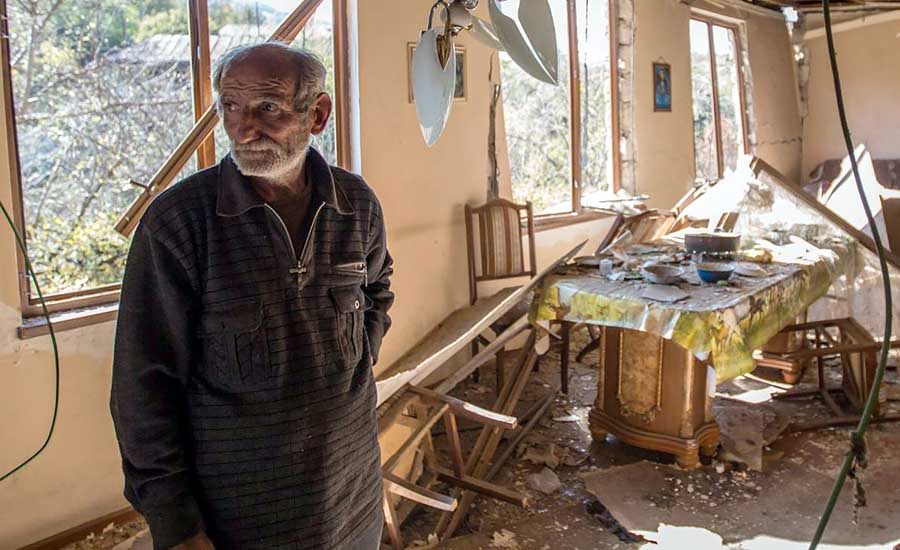Azerbaijan’s Aliyev Allocates $1 Million to UN Human Settlements Program, One Day Before The UN Mission’s Visit To Artsakh
On September 30, 2023, Azerbaijan’s President Ilham Aliyev signed an order on the allocation of funding to the United Nations Human Settlements Programme (UN-Habitat). This $1 million allocation comes one day before the UN mission visited Artsakh.
Under the presidential order, the UN-Habitat will be allocated $1 million in Azerbaijani manat equivalent from the Presidential Contingency Fund “in order to support the expansion of beneficial cooperation towards the development of sustainable cities in the world, as well as the strengthening of peace and security in this context.”
As previously reported, on October 2, the United Nations issued a bogus report after completing its mission in Artsakh (Nagorno-Karabakh) in just one day, stating “No incidences of violence against Armenian civilians” & “No damage to civilian public infrastructure, including hospitals, schools & housing, or to cultural & religious structures” in Stepanakert.
The United Nations failed to address the ethnic cleansing & genocide campaign conducted by Azerbaijan against the indigenous Armenians of Artsakh (Nagorno-Karabakh). In addition, the author of the UN report was Rashad Huseynov, a mouthpiece of the Aliyev regime.
As few as 50 to 1,000 ethnic Armenians are reported to be left in Artsakh (Nagorno-Karabakh) after the exodus of recent days saw more than 100,000 flee, the first UN mission to the region in 30 years.
The UN mission declared that it:
• “Did not come across any reports – neither from the local population interviewed nor from the interlocutors – of incidences of violence against civilians following the latest ceasefire.”
• “Saw no damage to civilian public infrastructure, including hospitals, schools, and housing, or to cultural & religious structures” in “parts of the city that the team visited.” The mission “saw that no shops were open.”
• “Was struck by the sudden manner in which the local population left their homes & the suffering the experience must have caused.”
United Nations Completes Mission In Artsakh After One Day & Issues Bogus Report Stating “No Violence Against Armenian Civilians & No Damage To Civilian Public Infrastructure”
The United Nations has issued a bogus report after completing its mission in Artsakh (Nagorno-Karabakh) in just one day, stating “No incidences of violence against Armenian civilians,” & “No damage to civilian public infrastructure, including hospitals, schools & housing, or to cultural & religious structures” in Stepanakert.
The United Nations failed to address the ethnic cleansing & genocide campaign conducted by Azerbaijan against the indigenous Armenians of Artsakh. In addition, the author of the UN report was Rashad Huseynov, a mouthpiece of the Aliyev regime.
As few as 50 to 1,000 ethnic Armenians are reported to be left in Artsakh (Nagorno-Karabakh) after the exodus of recent days saw more than 100,000 flee, the first UN mission to the region in 30 years.
The UN traveled to Artsakh & visited Stepanakert, where they allegedly met with the local population & saw first-hand the situation regarding health & education facilities.
The UN mission declared that it:
• “Did not come across any reports – neither from the local population interviewed nor from the interlocutors – of incidences of violence against civilians following the latest ceasefire.”
• “Saw no damage to civilian public infrastructure, including hospitals, schools, and housing, or to cultural & religious structures” in “parts of the city that the team visited.” The mission “saw that no shops were open.”
• “Saw very few local populations remaining in the city. The team heard from interlocutors that between 50 & 1,000 ethnic Armenians remain” in Artsakh, and it “was struck by the sudden manner in which the local population left their homes & the suffering the experience must have caused.”
• ”Had limited access to rural areas, no information was available on livestock & farming, including whether the farmers have access to or are ready for wheat sowing in the upcoming season. The mission did not observe any destruction of agricultural infrastructure or dead animals from the road.”
SOURCE: zartonkmedia


